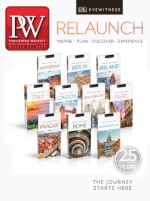Rosa Park and Richard Stapleton cofounded the biannual Cereal in 2012, because, Park says, they wanted to “produce a magazine that resonated with our peers on the subjects of travel and style.” This meant narrative-driven destination articles that focused on the experience of travel rather than the nitty-gritty details. Still, readers emailed asking the editors to recommend food and drink spots in the cities they covered.
In response, Park and Stapleton introduced digital companion guidebooks in 2013. Once again, fans responded: they wanted print versions. Cereal published its first bound guidebooks—to Copenhagen, London, Los Angeles, New York, and Paris—in September 2014; when Park and Stapleton sold out of multiple print runs, they realized they were onto something. They struck a deal with Abrams, which is releasing the next generation of Cereal City Guides—slender volumes on London, New York, and Paris—in October.
The guidebooks evoke the design-conscious quality found on the pages of Cereal but are more utilitarian, Park says, offering pared-down itineraries that are doable in a weekend, plus enough ideas to fill a weeklong stay. “We want to give you a list of 30 places that we’ve been to that really are our favorites,” she adds, with an emphasis on spots that mesh with Cereal’s “modern, calm, and elegant” branding.
Lifestyle publications with an international focus have proven fertile ground for spawning travel guides. Journalist Tyler Brûlé launched style magazine Wallpaper in 1996, and a decade later founded Monocle, a global affairs and lifestyle periodical. Each publication has since developed its own guidebook line reflecting the parent publication’s aesthetic.
Joe Pickard, books editor at Monocle, says its guides mirror the brand’s flagship magazine through their thorough reporting, snappy copy, and journalistic photography. Although helpful digital resources are plentiful, he notes, there’s no substitute for a physical book, and so “we’ve done everything we can to create a desirable object that people will want to own.”
The hardcover guides, printed on coated paper, cover restaurants favored by locals—“A family-run taverna or trattoria is more likely to find a place among our pages than an establishment glittering with Michelin stars,” Pickard says—as well as neighborhood itineraries, in-depth looks at architecture, and essays by contributors who live and work in the area. Marc Spiegler, global director of Art Basel, wrote about the festival’s genesis for the new guide to Zurich, Geneva, and Basel; in the new Mexico City guide, local journalist, musician, and documentary filmmaker Feike de Jong delved into the capital’s religious cults.
In November, Monocle adds books on Athens and Helsinki to its roster of guidebooks, all of which sport covers with upbeat, mid-century-style illustrations set against black backgrounds. Wallpaper City Guides, published by Phaidon, stand apart in a different way: each is sheathed in a single Pantone color; taken together, the collection resembles a fan of high-end paint chips.
Beneath the covers, most of the photography is original and devoid of people, putting the focus on interior design and architecture. The content stands in contrast to Cereal’s streamlined assemblage of venues and the personalities that help shape Monocle’s voice.
Another difference: regularly updating its 60-strong roster of locales, rather than bringing hot new destinations into the fold, is the priority. Fall will see new editions of guides to Melbourne, New York, Reykjavík, Shanghai, and four other cities.
Fashion, art, and architecture have been at the forefront of the compact guides. Executive editor Jeremy Case says it’s this loyalty to stylish, locals-approved establishments that has allowed the books to thrive as standalone products. “Many of our guidebook readers have told us that they’ve never actually picked up Wallpaper magazine,” he notes. “It’s a much wider audience.”
The magazine and website tend to be newsy, focusing on hotel and restaurant openings. A guidebook edition, by contrast, may be on sale for three years, which Case says means the editors try to recommend venues “that we believe will continue to be a draw for the foreseeable future.”



 Volume 265
Issue 33
08/13/2018
Volume 265
Issue 33
08/13/2018





